List of state leaders in 1945
| See also |
|---|
This is a list of heads of state, government leaders, and other rulers in the year 1945.
Africa
-
.svg.png) Egypt
Egypt
- Monarch - Farouk I, King of Egypt (1936–1952)
- Prime Minister -
- Ahmad Mahir Pasha, Prime Minister of Egypt (1944–1945)
- Mahmoud an-Nukrashi Pasha, Prime Minister of Egypt (1945–1946)
-
.svg.png) Ethiopia
Ethiopia
- Monarch - Haile Selassie, Emperor of Ethiopia (1930–1974)[1]
- Prime Minister - Makonnen Endelkachew, Prime Minister of Ethiopia (1942–1957)
-
 Liberia
Liberia
- President - William Tubman, President of Liberia (1944–1971)
-
.svg.png) South Africa
South Africa
- Monarch - George VI, King of the British Dominions Beyond the Seas (1936–1952)
- Governor-General - Nicolaas Jacobus de Wet, Officer Administering the Government of South Africa (1943–1946)
- Prime Minister - Jan Smuts, Prime Minister of South Africa (1939–1948)
Asia
-
.svg.png) Afghanistan
Afghanistan
- Monarch - Mohammed Zahir Shah, King of Afghanistan (1933–1973)
- Prime Minister - Mohammad Hashim Khan, Prime Minister of Afghanistan (1929–1946)
-
.svg.png) Burma (partially recognized occupied state)
Burma (partially recognized occupied state)
- independence terminated on 3 May 1945 with the end of Japanese occupation, afterwards British Burma was restored
- President - Ba Maw, President of Burma (1943–1945)
- Prime Minister - Ba Maw, Prime Minister of Burma (1942–1945)
- China
 Nationalist Government
Nationalist Government
- President - Chiang Kai-shek, Chairman of the National Government of China (1943–1949)
- Premier -
- Chiang Kai-shek, President of the Executive Yuan of China (1939–1945)
- T. V. Soong, President of the Executive Yuan of China (1945–1947)
.svg.png) Reorganized National Government (puppet state of Japan)
Reorganized National Government (puppet state of Japan)
- disbanded on 16 August 1945 following the Japanese surrender
- Head of State - Chen Gongbo, Acting Chairman of the National Government of China (1944–1945)
-
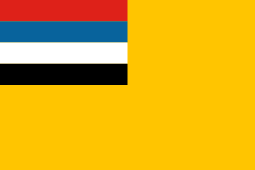 Manchukuo (partially recognized occupied state)
Manchukuo (partially recognized occupied state)
- reintegrated into China in 1945
- Monarch - Puyi, Emperor of Manchukuo (1934–1945)
- Prime Minister - Zhang Jinghui, Prime Minister of Manchukuo (1935–1945)
-
 East Turkestan (unrecognized secessionist state)
East Turkestan (unrecognized secessionist state)
- President - Elihan Tore, President of East Turkestan (1944–1946)
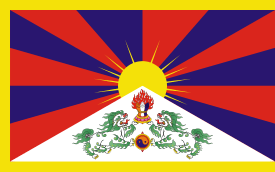 Tibet (unrecognized, de facto independent country)
Tibet (unrecognized, de facto independent country)
- Monarch - Tenzin Gyatso, Dalai Lama (1939–present)[2]
-
 Indonesia (unrecognized secessionist state)
Indonesia (unrecognized secessionist state)
- independence declared on 17 August 1945
- President - Sukarno, President of Indonesia (1945–1967)
- Prime Minister - Sutan Sjahrir, Prime Minister of Indonesia (1945–1947)
-
.svg.png) Iran
Iran
- Monarch - Mohammad Reza Pahlavi, Shah of Iran (1941–1979)
- Prime Minister -
- Morteza-Qoli Bayat, Prime Minister of Iran (1944–1945)
- Ebrahim Hakimi, Prime Minister of Iran (1945)
- Mohsen Sadr, Prime Minister of Iran (1945)
- Ebrahim Hakimi, Prime Minister of Iran (1945–1946)
-
 Azerbaijan People's Government (unrecognized autonomous republic)
Azerbaijan People's Government (unrecognized autonomous republic)
- declared independence on 12 December 1945
- Chairman - Ja'far Pishevari, Chairman of the Azerbaijan People's Government (1945–1946)
- Prime Minister - Ahmad Kordary, Prime Minister of the Azerbaijan People's Government (1945–1946)
-
.svg.png) Iraq
Iraq
- Monarch - Faisal II, King of Iraq (1939–1958)
- Regent - Crown Prince 'Abd al-Ilah, Regent of Iraq (1941–1953)
- Prime Minister - Hamdi al-Pachachi, Prime Minister of Iraq (1944–1946)
-
.svg.png) Japan (under Allied occupiation)
Japan (under Allied occupiation)
- occupied on 2 September 1945
- Monarch - Hirohito, Emperor of Japan (1926–1989)
- Prime Minister -
- Kuniaki Koiso, Prime Minister of Japan (1944–1945)
- Baron Suzuki Kantarō, Prime Minister of Japan (1945)
- Prince Higashikuni Naruhiko, Prime Minister of Japan (1945)
- Baron Kijūrō Shidehara, Prime Minister of Japan (1945–1946)
- Military Governor - Douglas MacArthur, Supreme Commander of the Allied Powers (1945–1951)
-
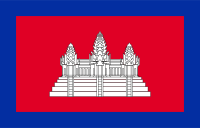 Cambodia (unrecognized state)
Cambodia (unrecognized state)
- claimed independence (under Japanese occupation) as the Kingdom of Cambodia between 12 March - 16 October 1945, afterwards returned to French Indochina as Cambodia
- Monarch - Norodom Sihanouk, King of Cambodia (1941–1955)
- Prime Minister -
- Norodom Sihanouk, Prime Minister of Cambodia (1945)
- Son Ngoc Thanh, Prime Minister of Cambodia (1945)
- Prince Sisowath Monireth, Prime Minister of Cambodia (1945–1946)
-
 Lebanon
Lebanon
- President - Bechara El Khoury, President of Lebanon (1943–1952)
- Prime Minister -
- Riad Al Solh, Prime Minister of Lebanon (1943–1945)
- Abdul Hamid Karami, Prime Minister of Lebanon (1945)
- Sami as-Solh, Prime Minister of Lebanon (1945–1946)
-
.svg.png) Mongolia
Mongolia
- Communist Party Leader - Yumjaagiin Tsedenbal, General secretary of the Central Committee of the Mongolian People's Revolutionary Party (1940–1954)
- Head of State - Gonchigiin Bumtsend, Chairman of the Presidium of the State Little Hural of Mongolia (1940–1953)
- Premier - Khorloogiin Choibalsan, Chairman of the Council of Ministers of Mongolia (1939–1952)
-
 Muscat and Oman
Muscat and Oman
- Monarch - Said Bin Taimur, Sultan of Muscat and Oman (1932–1970)
-
.svg.png) Nepal
Nepal
- Monarch - Tribhuvan, King of Nepal (1911–1950)
- Prime Minister -
- Juddha Shamsher Jang Bahadur Rana, Prime Minister of Nepal (1932–1945)
- Padma Shamsher Jang Bahadur Rana, Prime Minister of Nepal (1945–1948)
-
 Philippines (partially recognized occupied state)
Philippines (partially recognized occupied state)
- independence terminated on 17 August 1945 with the end of Japanese occupation, afterwards the Commonwealth of the Philippines was restored
- President -
- José P. Laurel, President of the Philippines (1943–1945)
- Sergio Osmeña, President of the Commonwealth of the Philippines (1944–1946)
-
.svg.png) Saudi Arabia
Saudi Arabia
- Monarch - Ibn Saud, King of Saudi Arabia (1902–1953)[3]
-
 Siam
Siam
- Thailand changed name to Siam on September 8, 1945
- Monarch - Ananda Mahidol, King of Siam (1935–1946)
- Regent - Pridi Banomyong, Regent of Siam (1944–1945)
- Prime Minister -
- Khuang Aphaiwong, Prime Minister of Siam (1944–1945)
- Tawee Boonyaket, Prime Minister of Siam (1945)
- Seni Pramoj, Prime Minister of Siam (1945–1946)
- Thailand
- see under Siam
-
 Turkey
Turkey
- President - İsmet İnönü, President of Turkey (1938–1950)
- Prime Minister - Şükrü Saracoğlu, Prime Minister of Turkey (1942–1946)
-
.svg.png) Empire of Vietnam (unrecognized occupied state)
Empire of Vietnam (unrecognized occupied state)
- independence declared under Japanese occupation 9 March - 15 August 1945
- Monarch - Bảo Đại, Emperor of Vietnam (1926–1945)
- Prime Minister - Trần Trọng Kim, Prime Minister of Vietnam (1945)
-
.svg.png) North Vietnam (Democratic Republic of Vietnam)
North Vietnam (Democratic Republic of Vietnam)
- declared independence on 2 September 1945
- Communist Party Leader - Trường Chinh, General Secretary of the Communist Party of Vietnam (1941–1956)
- President - Hồ Chí Minh, President of North Vietnam (1945–1969)
- Premier - Hồ Chí Minh, Chairman of the Council of Ministers of North Vietnam (1945–1955)
-
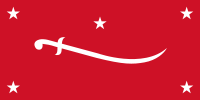 Yemen
Yemen
- Monarch - Yahya Muhammad Hamid ed-Din, King of Yemen (1904–1948)[4]
Europe
-
.svg.png) Albania
Albania
- Communist Party Leader - Enver Hoxha, First Secretary of the Albanian Party of Labor (1944–1985)
- Head of State - Omer Nishani, Chairman of the Presidium of the Antifascist Council of National Liberation of Albania (1944–1953)
- Premier - Enver Hoxha, Chairman of the Council of Ministers of Albania (1944–1954)
-
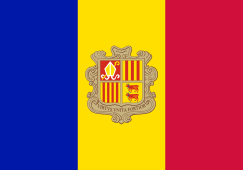 Andorra
Andorra
- Monarchs -
- French Co-Prince - Charles de Gaulle, French Co-Prince of Andorra (1944–1946)
- Co-Prince's Representative -
- Robert Barran (1944–1945)
- Georges Degrand (1945–1947)
- Co-Prince's Representative -
- Episcopal Co-Prince - Ramon Iglesias i Navarri, Episcopal Co-Prince of Andorra (1943–1969)
- Co-Prince's Representative - Jaume Sansa Nequí (1937–1972)
- French Co-Prince - Charles de Gaulle, French Co-Prince of Andorra (1944–1946)
- First Syndic - Francesc Cairat Freixes, First Syndic of Andorra (1937–1960)
- Monarchs -
-
 Austria (under Allied occupation)
Austria (under Allied occupation)
- was declared to be independent from the Greater German Reich on 27 April 1945
- President - Karl Renner, Federal President of Austria (1945–1950)
- Chancellor -
- Karl Renner, Chancellor of Austria (1945)
- Leopold Figl, Federal Chancellor of Austria (1945–1953)
- American high commissioner - Mark W. Clark (1945–1947)
- British high commissioner - Sir Richard McCreery (1945–1946)
- French high commissioner - Antoine Béthouart (1945–1950)
- Soviet high commissioner - Ivan Konev (1945–1946)
-
.svg.png) Belgium
Belgium
- Monarch - Leopold III, King of the Belgians (1934–1951)[5]
- Regent - Prince Charles, Count of Flanders, Regent of Belgium (1944–1950)
- Prime Minister -
- Hubert Pierlot, Prime Minister of Belgium (1939–1945)[6]
- Achille van Acker, Prime Minister of Belgium (1945–1946)
-
 Bulgaria
Bulgaria
- Monarch - Simeon II, Tsar of the Bulgarians (1943–1946)
- Regents - Venelin Ganev + Todor Pavlov + Tsvetko Boboshevski, Regency Council of Bulgaria (1944–1946)
- Premier - Kimon Georgiev, Chairman of the Council of Ministers of Bulgaria (1944–1946)
-
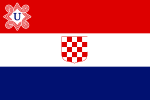 Croatia (partially recognized occupied state)
Croatia (partially recognized occupied state)
- ceased to exist in May 1945, re-integrated into Yugoslavia
- Head of State - Ante Pavelić, Leader of Croatia (1941–1945)
- Prime Minister - Nikola Mandić, Prime Minister of Croatia (1943–1945)
-

 Czechoslovakia
Czechoslovakia
- Czechoslovakia reconstituted on 3 April 1945 after the Protectorate of Bohemia and Moravia seceded from the Greater German Reich
- President -
- Emil Hácha, State President of Bohemia and Moravia (1938–1945)[7]
- Edvard Beneš, President of Czechoslovakia (1945–1948)
- Prime Minister -
- Jaroslav Krejčí, Prime Minister of Bohemia and Moravia (1942–1945)
- Richard Bienert, Prime Minister of Bohemia and Moravia (1945)
- Zdeněk Fierlinger, Prime Minister of Czechoslovakia (1945–1946)
- German Governor - Wilhelm Frick, Reichsprotektor of Bohemia and Moravia (1943–1945)
- Czechoslovak government-in-exile
- the government returned on April 2, 1945
- President - Edvard Beneš, President of Czechoslovakia (1940–1945)
- Prime Minister - Jan Šrámek, Prime Minister of Czechoslovakia (1940–1945)
-
 Denmark
Denmark
- regained independence with the end of the German occupation on 4 May 1945
- Monarch - Christian X, King of Denmark (1912–1947)
- Prime Minister -
- Vilhelm Buhl, Prime Minister of Denmark (1945)
- Knud Kristensen, Prime Minister of Denmark (1945–1947)
- German Governor - Werner Best, Reich Plenipotentiary in Denmark (1942–1945)
-
 Finland
Finland
- President - Baron Carl Gustaf Emil Mannerheim, President of Finland (1944–1946)
- Prime Minister - Juho Kusti Paasikivi, Prime Minister of Finland (1944–1946)
-
 France
France
- Head of State - Charles de Gaulle, Chairman of the Provisional Government of France (1944–1946)
-
.svg.png)
.svg.png) Germany (under Allied occupation)
Germany (under Allied occupation)
- the Greater German Reich was occupied in May 1945
- Head of State -
- Adolf Hitler, Führer of Germany (1934–1945)
- Karl Dönitz, President of Germany (1945)
- Chancellor -
- Adolf Hitler, Chancellor of Germany (1933–1945)
- Joseph Goebbels, Chancellor of Germany (1945)
- Lutz Graf Schwerin von Krosigk, Leading Minister of Germany (1945)
- American Zone
- British Zone
- Military Governor - Bernard Montgomery, Military Governor of the British Occupation Zone of Germany (1945–1946)
- French Zone
- Military Governor - Marie-Pierre Kœnig, Military Governor of the French Occupation Zone of Germany (1945–1949)
- Soviet Zone
- Military Governor - Georgy Zhukov, Military Governor of the Soviet Occupation Zone of Germany (1945–1946)
-
.svg.png) Greece
Greece
- Monarch - George II, King of the Hellenes (1935–1947)[8]
- Regent - Archbishop Damaskinos, Regent of Greece (1944–1946)
- Prime Minister -
- Georgios Papandreou, President of the Ministerial Council of Greece (1944–1945)
- Nikolaos Plastiras, President of the Ministerial Council of Greece (1945)
- Petros Voulgaris, President of the Ministerial Council of Greece (1945)
- Archbishop Damaskinos, President of the Ministerial Council of Greece (1945)
- Panagiotis Kanellopoulos, President of the Ministerial Council of Greece (1945)
- Themistoklis Sophoulis, President of the Ministerial Council of Greece (1945–1946)
-
.svg.png) Hungary
Hungary
- with the collapse of the German-occupied Government of National Unity in May 1945, the country reverted to the Kingdom of Hungary
- Head of State -
- Ferenc Szálasi, Leader of the Nation of Hungary (1944–1945)
- High National Council, Head of State of Hungary (1945–1946)
- Prime Minister -
- Béla Miklós, Prime Minister of Hungary (rival government) (1944–1945)
- Zoltán Tildy, Prime Minister of Hungary (1945–1946)
-
 Iceland
Iceland
- President - Sveinn Björnsson, President of Iceland (1944–1952)[9]
- Prime Minister - Ólafur Thors, Prime Minister of Iceland (1944–1947)
-
 Ireland
Ireland
- Monarch - George VI, King of Ireland (1936–1949)
- President -
- Douglas Hyde, President of Ireland (1938–1945)
- Seán T. O'Kelly, President of Ireland (1945–1959)
- Prime Minister - Éamon de Valera, Taoiseach of Ireland (1932–1948)
- Italy
-
_crowned.svg.png) Kingdom of Italy
Kingdom of Italy
- Monarch - Victor Emmanuel III, King of Italy (1900–1946)
- Regent - Prince Umberto, Prince of Piedmont, Lieutenant General of the Realm of Italy (1944–1946)
- Prime Minister -
-
 Italian Social Republic (partially recognized state under German occupation)
Italian Social Republic (partially recognized state under German occupation)
- ceased to exist on 25 April 1945
- Head of State - Benito Mussolini, Provisional Head of State of the Italian Social Republic (1943–1945)
-
-
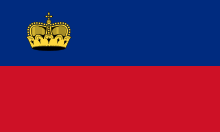 Liechtenstein
Liechtenstein
- Monarch - Franz Joseph II, Prince of Liechtenstein (1938–1989)
- Prime Minister -
- Josef Hoop, Head of Government of Liechtenstein (1928–1945)
- Alexander Frick, Head of Government of Liechtenstein (1945–1962)
-
 Luxembourg
Luxembourg
- Monarch - Charlotte, Grand Duchess of Luxembourg (1919–1964)[10]
- Prime Minister - Pierre Dupong, President of the Government of Luxembourg (1937–1953)[11]
-
 Monaco
Monaco
- Monarch - Louis II, Prince of Monaco (1922–1949)
- Head of Government - Pierre de Witasse, Minister of State of Monaco (1944–1948)
-
.svg.png)
 Netherlands
Netherlands
- regained independence with the collapse of Reichskommissariat Niederlande in May 1945, and the government-in-exile returned on May 23
- German Governor - Arthur Seyss-Inquart, Reichskommissar in the Netherlands (1940–1945)
- Monarch - Wilhelmina, Queen of the Netherlands (1890–1948)[12]
- Prime Minister -
- Pieter Sjoerds Gerbrandy, Prime Minister of the Netherlands (1940–1945)[13]
- Wim Schermerhorn, Prime Minister of the Netherlands (1945–1946)
-
.svg.png)
 Norway
Norway
- regained independence on 7 May 1945 with the collapse of the Reichskommissariat Norwegen and the government-in-exile returned on May 31
- German Governor -
- Josef Terboven, Reichskommissar in Norway (1940–1945)
- Franz Böhme, Reichskommissar in Norway (1945)
- Monarch - Haakon VII, King of Norway (1905–1957)[14]
- Prime Minister -
- Vidkun Quisling, Minister President of Norway (1942–1945)
- Johan Nygaardsvold, Prime Minister of Norway (1935–1945)[15]
- Einar Gerhardsen, Prime Minister of Norway (1945–1951)
-
 Poland
Poland
- German annexation ended in early 1945
- Communist Party Leader - Władysław Gomułka, First Secretary of the Central Committee of Polish United Workers' Party (1943–1948)
- Head of State - Bolesław Bierut, President of the Presidium of the Popular Council of Poland (1944–1952)
- Premier - Edward Osóbka-Morawski, President of the Council of Ministers of Poland (1944–1947)
- Polish government-in-exile
- lost most of its recognition in 1945
- President - Władysław Raczkiewicz, President of Poland (1939–1947)
- Prime Minister - Tomasz Arciszewski, Prime Minister of Poland (1944–1947)
-
 Portugal
Portugal
- President - Óscar Carmona, President of Portugal (1926–1951)
- Premier - António de Oliveira Salazar, President of the Council of Ministers of Portugal (1932–1968)
-
 Romania
Romania
- Monarch - Michael I, King of the Romanians (1940–1947)
- Premier -
-
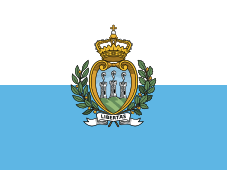 San Marino
San Marino
- Captains Regent -
- Teodoro Lonfernini and Leonida Suzzi Valli, Captains Regent of San Marino (1944–1945)
- Alvaro Casali and Vittorio Valentini, Captains Regent of San Marino (1945)
- Ferruccio Martelli and Secondo Fiorini, Captains Regent of San Marino (1945–1946)
- Captains Regent -
-
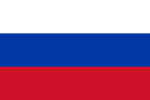 Slovakia (partially recognized occupied state)
Slovakia (partially recognized occupied state)
- ceased to exist and re-joined Czechoslovakia on 4 April 1945
- President - Jozef Tiso, President of Slovakia (1939–1945)
- Prime Minister - Štefan Tiso, Prime Minister of Slovakia (1944–1945)
-
.svg.png) Soviet Union
Soviet Union
- Communist Party Leader - Joseph Stalin, General Secretary of the Communist Party of the Soviet Union (1922–1953)
- Head of State - Mikhail Kalinin, Chairman of the Presidium of the Supreme Soviet of the Soviet Union (1922–1946)
- Premier - Joseph Stalin, Chairman of the Council of People's Commissars of the Soviet Union (1941–1953)
-
.svg.png)
.svg.png) Spain
Spain
- Head of State - Francisco Franco, Head of State of Spain (1936–1975)
- Prime Minister - Francisco Franco, President of the Government of Spain (1938–1973)
-
 Sweden
Sweden
- Monarch - Gustaf V, King of Sweden (1907–1950)
- Prime Minister - Per Albin Hansson, Prime Minister of Sweden (1936–1946)
-
 Switzerland
Switzerland
- Federal Council:[16]
- Philipp Etter (1934–1959), Walther Stampfli (1940–1947), Enrico Celio (1940–1950), Eduard von Steiger (1940–1951, President), Karl Kobelt (1940–1954), Ernst Nobs (1943–1951), Max Petitpierre (1944–1961)
- Federal Council:[16]
-
 United Kingdom
United Kingdom
- Monarch - George VI, King of the United Kingdom (1936–1952)
- Prime Minister -
- Winston Churchill, Prime Minister of the United Kingdom (1940–1945)
- Clement Attlee, Prime Minister of the United Kingdom (1945–1951)
-
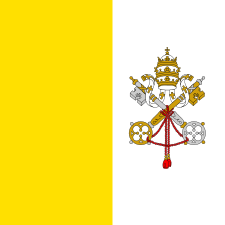 Vatican City
Vatican City
- Monarch - Pope Pius XII, Sovereign of Vatican City (1939–1958)
- Governor - Marquis Camillo Serafini, Governor of Vatican City (1929–1952)
- President of the Governorate - Cardinal Nicola Canali, President of the Governorate of Vatican City (1939–1961)
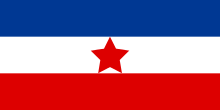 Yugoslavia
Yugoslavia
- Communist Party leader - Josip Broz Tito, General Secretary of the Yugoslav Communist Party (1936–1980)
- Head of State - Ivan Ribar, President of the Presidium of the National Assembly of Yugoslavia (1943–1953)
- Prime Minister - Josip Broz Tito, Prime Minister of Yugoslavia[17] (1943–1963)
- Yugoslav government-in-exile
- the government-in-exile merged with the government in Belgrade in March and the monarchy was abolished on November 29, 1945
- Monarch - Peter II, King of Yugoslavia (1934–1945)[18]
- Prime Minister - Ivan Šubašić, Prime Minister of Yugoslavia (1944–1945)
North America
-
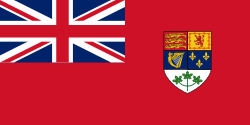 Canada
Canada
- Monarch - George VI, King of the British Dominions Beyond the Seas (1936–1952)
- Governor General - Alexander Cambridge, Earl of Athlone, Governor General of Canada (1940–1946)
- Prime Minister - William Lyon Mackenzie King, Prime Minister of Canada (1935–1948)
-
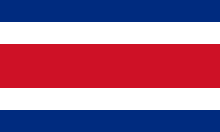 Costa Rica
Costa Rica
- President - Teodoro Picado Michalski, President of Costa Rica (1944–1948)
-
 Cuba
Cuba
- President - Ramón Grau, President of Cuba (1944–1948)
- Premier -
- Félix Lancís Sánchez, Premier of Cuba (1944–1945)
- Carlos Prío Socarrás, Premier of Cuba (1945–1947)
-
 Dominican Republic
Dominican Republic
- De facto Head of State - Rafael Trujillo, de facto ruler of the Dominican Republic (1930–1961)
- President - Rafael Trujillo, President of the Dominican Republic (1942–1952)
-
 El Salvador
El Salvador
- President -
- Osmín Aguirre y Salinas, Provisional President of El Salvador (1944–1945)
- Salvador Castaneda Castro, President of El Salvador (1945–1948)
- President -
-
 Guatemala
Guatemala
- President -
- Revolutionary Government Junta, Head of State of Guatemala (1944–1945)
- Juan José Arévalo, President of Guatemala (1945–1951)
- President -
-
.svg.png) Haiti
Haiti
- President - Élie Lescot, President of Haiti (1941–1946)
-
 Honduras
Honduras
- President - Tiburcio Carías Andino, President of Honduras (1933–1949)
-
.png) Mexico
Mexico
- President - Manuel Ávila Camacho, President of Mexico (1940–1946)
-
 Nicaragua
Nicaragua
- President - Anastasio Somoza García, President of Nicaragua (1937–1947)
-
 Panama
Panama
- President -
- Ricardo Adolfo de la Guardia Arango, President of Panama (1941–1945)
- Enrique Adolfo Jiménez, Provisional President of Panama (1945–1948)
- President -
-
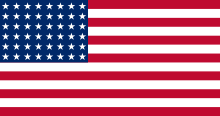 United States of America
United States of America
- President -
- Franklin D. Roosevelt, President of the United States (1933–1945)
- Harry S. Truman, President of the United States (1945–1953)
- President -
Oceania
-
 Australia
Australia
- Monarch - George VI, King of the British Dominions Beyond the Seas (1936–1952)
- Governor-General -
- Prime Minister -
- John Curtin, Prime Minister of Australia (1941–1945)
- Frank Forde, Prime Minister of Australia (1945)
- Ben Chifley, Prime Minister of Australia (1945–1949)
-
 New Zealand
New Zealand
- Monarch - George VI, King of the British Dominions Beyond the Seas (1936–1952)
- Governor-General - Sir Cyril Newall, Governor-General of New Zealand (1941–1946)
- Prime Minister - Peter Fraser, Prime Minister of New Zealand (1940–1949)
South America
-
 Argentina
Argentina
- President - Edelmiro Julián Farrell, President of Argentina (1944–1946)
-
 Bolivia
Bolivia
- President - Gualberto Villarroel, President of Bolivia (1944–1946)
-
.svg.png) Brazil
Brazil
- President -
- Getúlio Vargas, President of Brazil (1930–1945)
- José Linhares, President of Brazil (1945–1946)
- President -
-
 Chile
Chile
- President - Juan Antonio Ríos, President of Chile (1942–1946)
-
 Colombia
Colombia
- President -
- Alfonso López Pumarejo, President of Colombia (1942–1945)
- Alberto Lleras Camargo, President of Colombia (1945–1946)
- President -
-
 Ecuador
Ecuador
- President - José María Velasco Ibarra, President of Ecuador (1944–1947)
-
.svg.png) Paraguay
Paraguay
- President - Higinio Moríñigo, President of Paraguay (1940–1948)
-
.svg.png) Peru
Peru
- President -
- Manuel Prado Ugarteche, President of Peru (1939–1945)
- José Bustamante y Rivero, President of Peru (1945–1948)
- Prime Minister -
- Manuel Cisneros Sánchez, President of the council of ministers of Peru (1944–1945)
- Rafael Belaúnde Diez Canseco, President of the council of ministers of Peru (1945–1946)
- President -
-
 Uruguay
Uruguay
- President - Juan José de Amézaga, President of Uruguay (1943–1947)
-
.svg.png) Venezuela
Venezuela
- President -
- Isaías Medina Angarita, President of Venezuela (1941–1945)
- Romulo Betancourt, President of Venezuela (1945–1948)
- President -
References
- ↑ In exile between 1936 and 1941.
- ↑ Tenzin Gyatso was only enthroned in 1950, Tibet accepted Chinese sovereignty in 1951, the Dalai Lama went into exile in 1959, and his political role in the government-in-exile ended in 2011.
- ↑ Ibn Saud was Emir of Nejd and Hasa between 1902 and 1921, Sultan of Nejd between 1921 and 1927, King of Nejd between 1927 and 1932 additionally King of Hejaz between 1926 and 1932 (collectively referred to as King of Nejd and Hejaz), and King of Saudi Arabia from 1932.
- ↑ Yemen only became independent in 1918.
- ↑ German prisoner between 1940 an 1945, in exile between 1945 and 1950.
- ↑ In exile between 1940 and 1944.
- ↑ Hácha was President of Czechoslovakia between 1938 and 1939.
- ↑ In exile between 1941 and 1946.
- ↑ Björnsson was regent under the kingdom between 1941 and 1944.
- ↑ In exile between 1940 and 1945.
- ↑ In exile between 1940 and 1944.
- ↑ In exile between 1940 and 1945.
- ↑ In exile.
- ↑ In exile between 1940 and 1945.
- ↑ In exile between 1940 and 1945.
- ↑ The seven member Swiss Federal Council is the collective head of state and the government of Switzerland. Within the Council, the President of the Swiss Confederation serves solely in a primus inter pares capacity for one year.
- ↑ Title changed from Chairman of the Executive Council of the Anti-Fascist Council of National Liberation to Prime Minister on March 7, 1945
- ↑ In exile from 1941.
External links
This article is issued from Wikipedia - version of the 11/8/2016. The text is available under the Creative Commons Attribution/Share Alike but additional terms may apply for the media files.